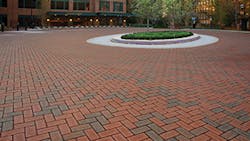Editor’s note: This article first appeared in the January-February 2016 issue of Erosion Control.
Energy consumption and the wise use of water and other natural resources is taken seriously at the US Department of Energy’s National Renewable Energy Laboratory (NREL) in Golden, CO. Of the seven LEED-certified buildings at NREL, six qualified for the LEED Platinum rating.
Each building on the NREL campus was designed to be energy efficient and environmentally friendly, inside and outside. Permeable pavers helped the NREL earn its LEED ratings. They were installed in five separate areas as buildings were added to the campus.
Editor's note: This article first appeared in the January-February 2016 issue of Erosion Control. Energy consumption and the wise use of water and other natural resources is taken seriously at the US Department of Energy’s National Renewable Energy Laboratory (NREL) in Golden, CO. Of the seven LEED-certified buildings at NREL, six qualified for the LEED Platinum rating. Each building on the NREL campus was designed to be energy efficient and environmentally friendly, inside and outside. Permeable pavers helped the NREL earn its LEED ratings. They were installed in five separate areas as buildings were added to the campus. [text_ad]The first project was done in the summer of 2010. Three hundred linear feet of pavers were installed on the campus road along with 11,000 square feet of pavers at the Research and Support Facility (RSF) plaza.
The next RSF installation of permeable pavers, in the summer of 2011, included 1,400 linear feet on the campus road and 3,000 square feet at the plaza. The third RSF installation, during summer 2012, involved 350 linear feet on the campus road and 9,000 square feet on the plaza.
Earlier that year, in spring, permeable pavers were installed at the Energy Systems Integration Facility, the building that houses NREL’s supercomputer. The fifth project, in spring 2014, involved installing 750 linear feet of permeable pavers on the campus road.
Each area of permeable pavers at NREL has an underdrain system. These drains were necessary because of the poor infiltration rate of the soil.
“The soils on our site do not promote infiltration well as far as storage. [The permeable pavers] reduce the peak flow minimally,” says Michelle Slovensky, LEED AP BD+C, energy program manager at NREL. “We have a gravel underdrain system that collects and conveys [runoff] to our watershed basins that ultimately reach our detention pond. Its most effective use has been from a water-quality aspect. The filtration helps strip impurities that would otherwise reach our downstream discharge.”
All of the pavers at NREL are Eco-Priora from Uni-Paver, a division of Uni-Group USA. They were manufactured by the Pavestone Co. of Henderson, CO.
The design/build team was Haselden Construction of Centennial, CO, and RNL Design of Denver. Installation was done by Continental Hardscape Systems of Westminster, CO.
Pavestone blended together two of its standard paver colors, tan and limestone, to make a custom shade for all of the NREL pavers. This custom color has a higher solar reflectivity index (SRI), thus lowering heat gain on the NREL campus. Lower heat gain means less energy required for cooling and earns more LEED points.
“We call it ‘LEED White,’” says Mike Midyett, Pavestone’s general manager.
The Eco-Priora permeable pavers are 3.125 inches thick. Below the pavers is a 2-inch-thick bedding and joints layer composed of ASTM No. 8 stone.
The 12-inch-thick base layer directly below the bedding and joints layer is not composed of the usual stone. Instead, it consists of recycled concrete. Using this recycled material offered two advantages: it earned additional LEED points and it cost less than the stone.
Concrete bands separated the paving areas, and work space was tight. The pavers were installed by hand.
Eco-Priora pavers can be produced in a variety of square and rectangular sizes. Because they require minimal chamfers and have narrower joints than some others, they are ideal for pedestrian and ADA handicap-accessible paved areas. Eco-Priora pavers are also suitable for locations that have vehicular traffic.
The narrow pavers left room for the installation of solar paver lights in the outdoor café area for employees and their guests. The pavers are interspersed with small bioretention areas. Native plants in these areas include Rocky Mountain penstemon, desert four o’clock, and pussytoes.
Permeable pavers produced years ago did not always perform well when installed in cold climates; the repeated freezing and thawing sometimes caused damage. Fortunately that has not been the case with the Eco-Priora permeable pavers at NREL.
“There have been no issues of system failure or location displacement of the pavers in Colorado’s cold climate. In fact, they have reduced ice buildup since we have warm sunny days in winter. No ponding issues occurred in any location,” says Slovensky.
Maintenance needs are minimal. “Special equipment is necessary for snow removal, but when the correct equipment is used it poses no issues,” says Slovensky. “From time to time a topoff [is needed.] The gravel in between pavers must be replenished.”


